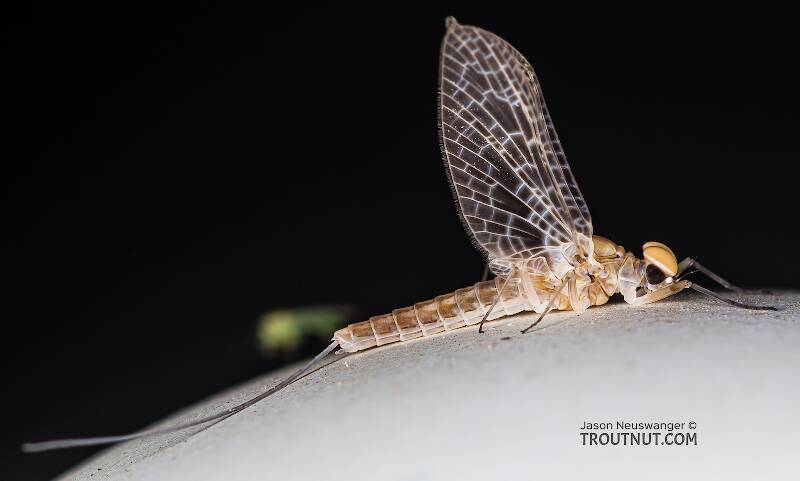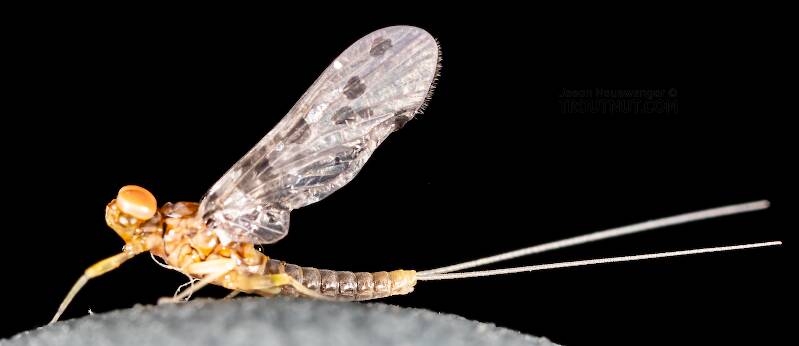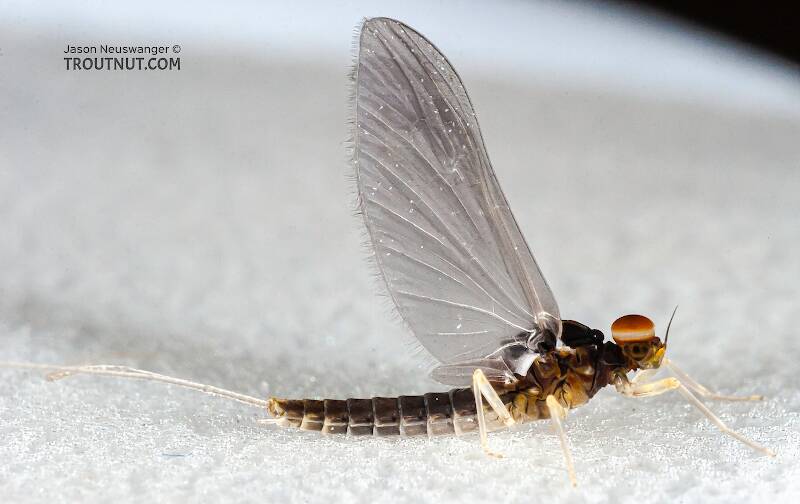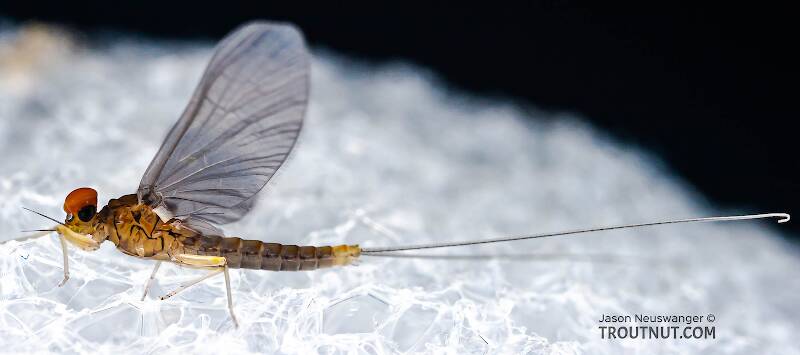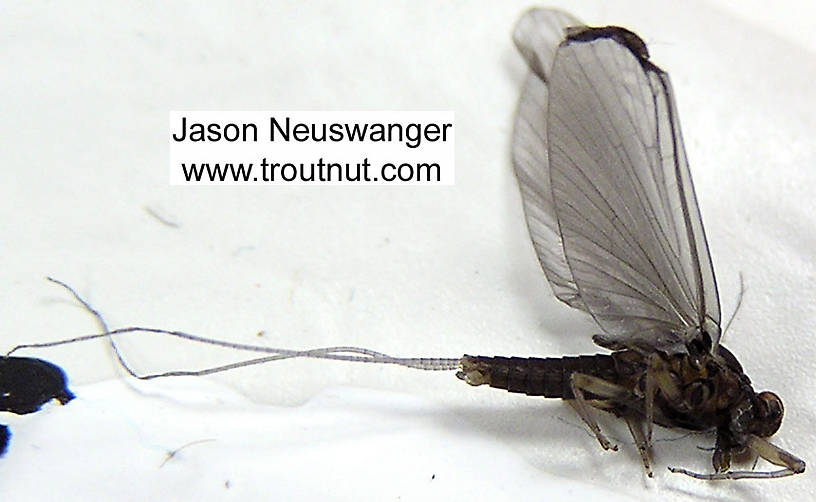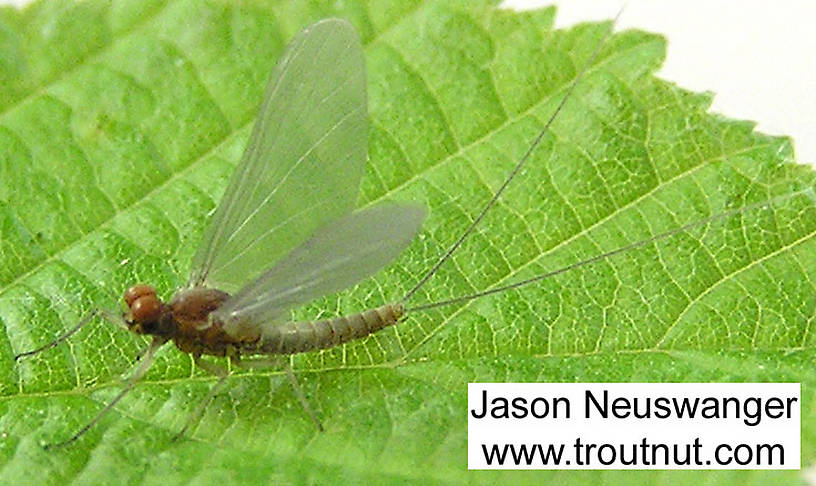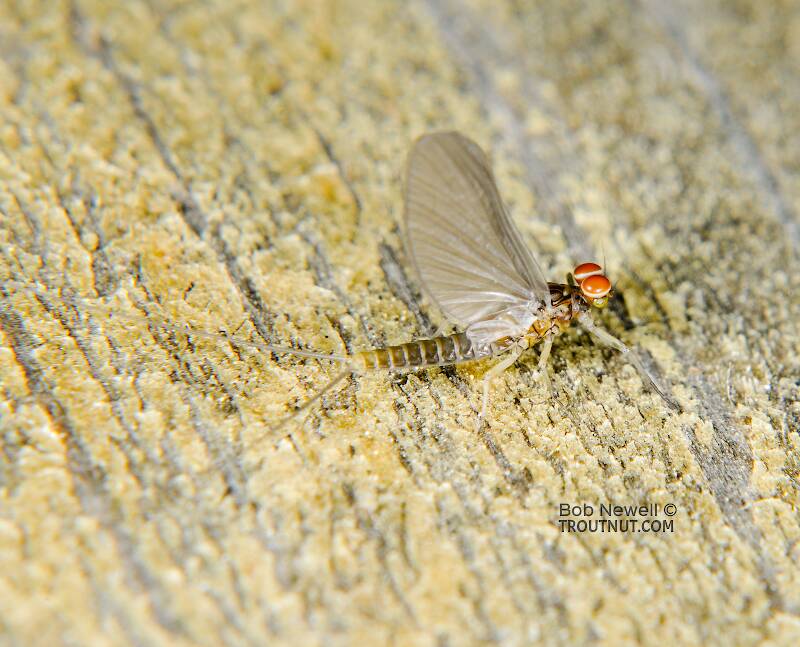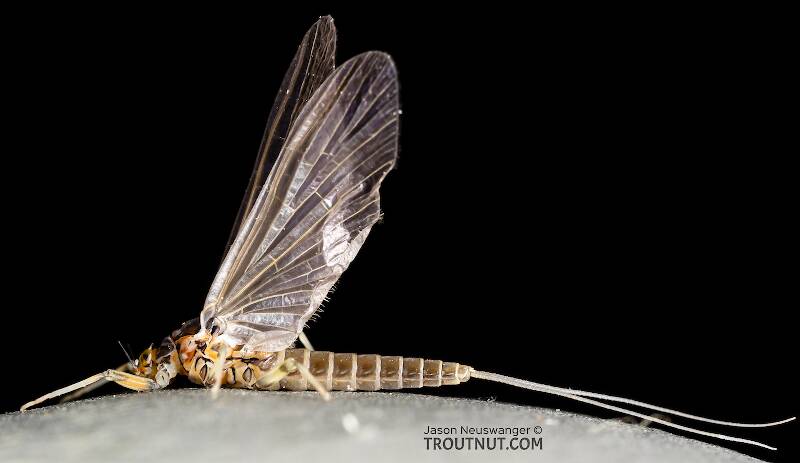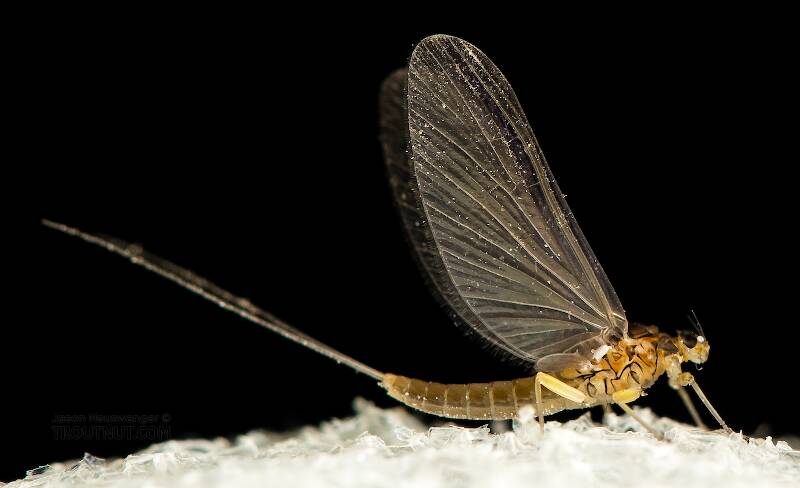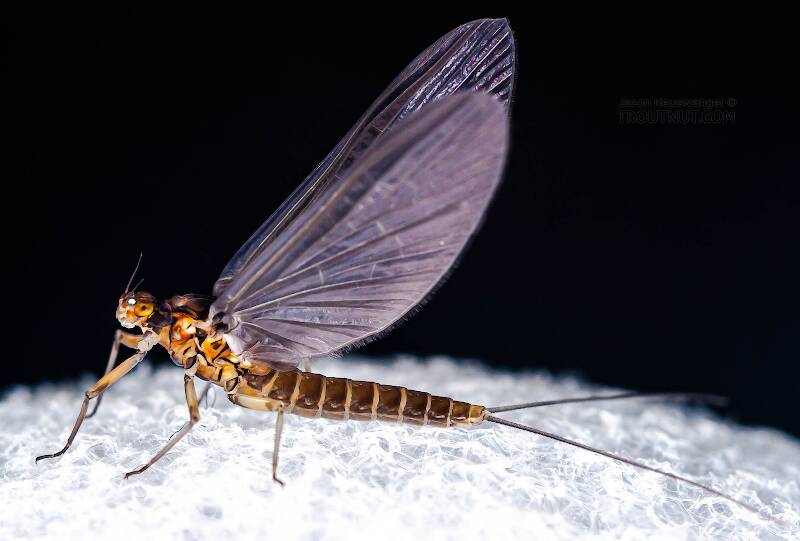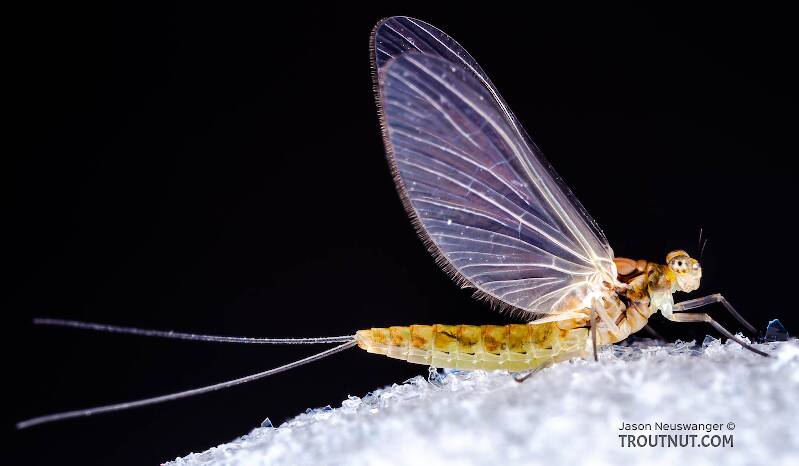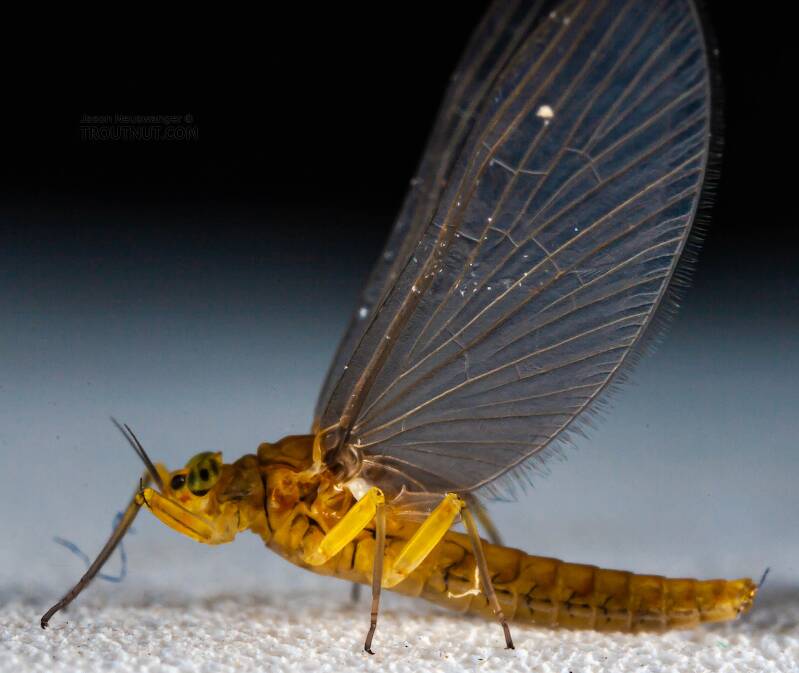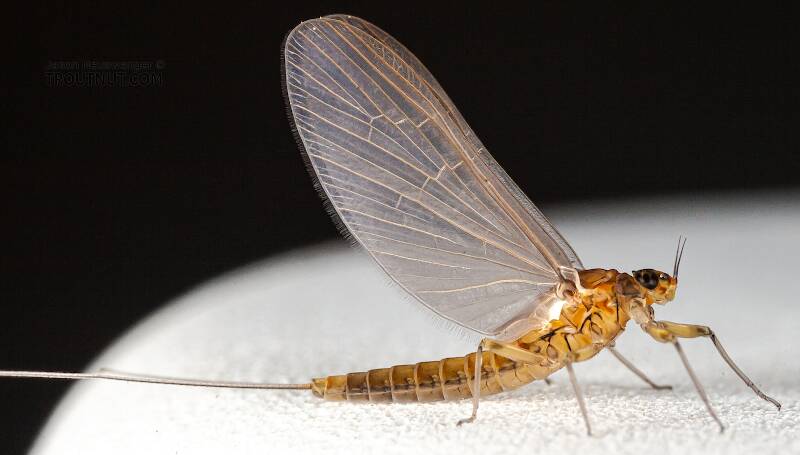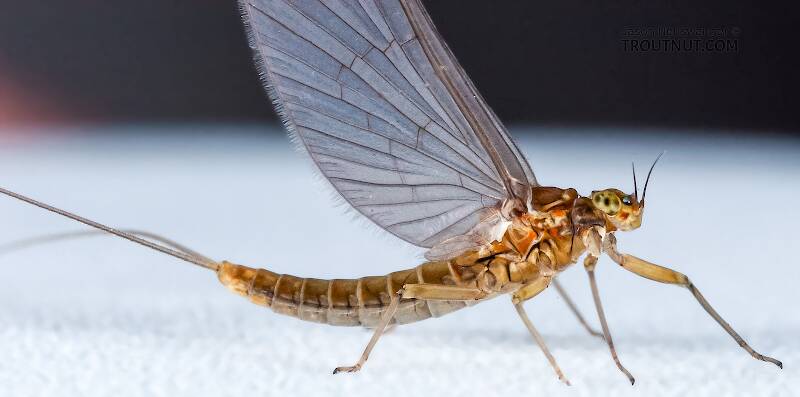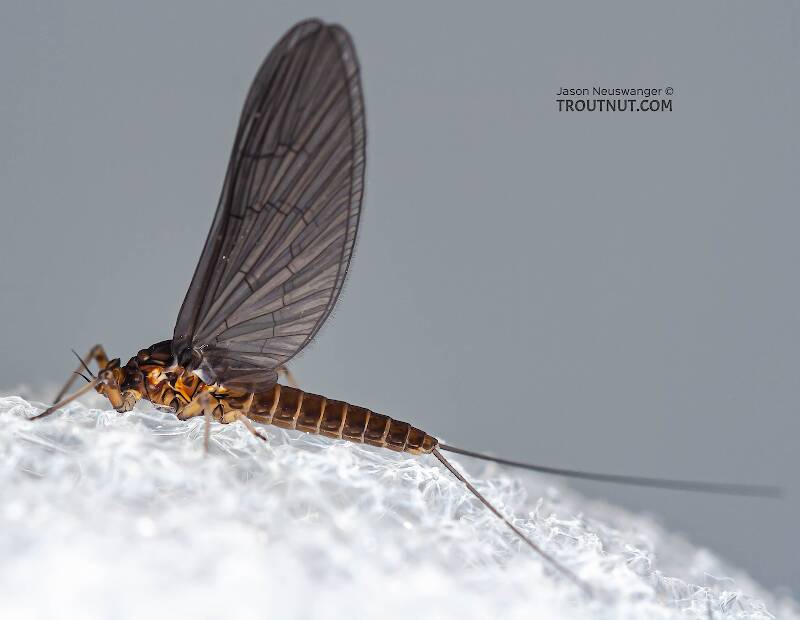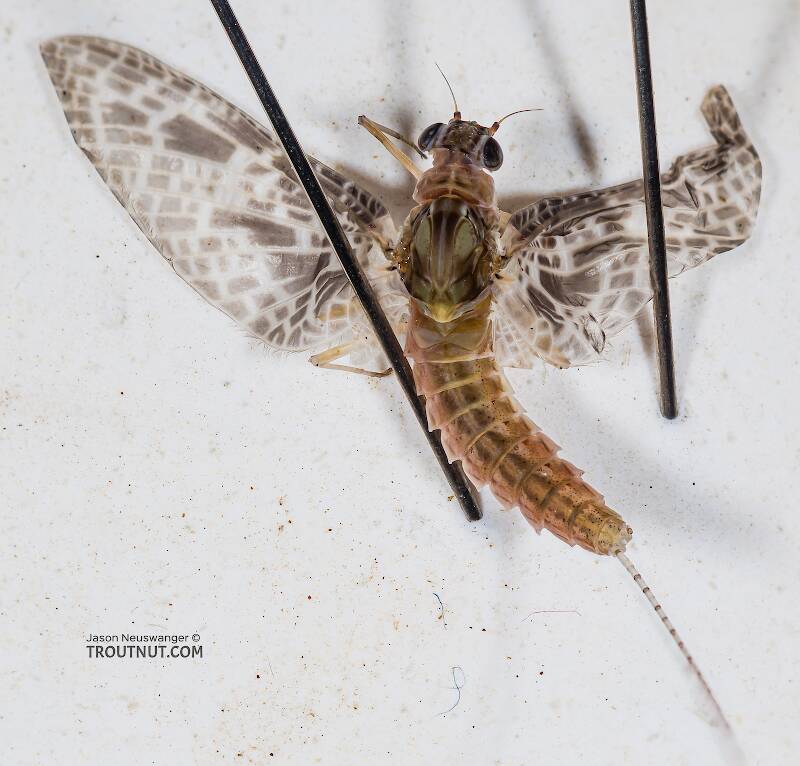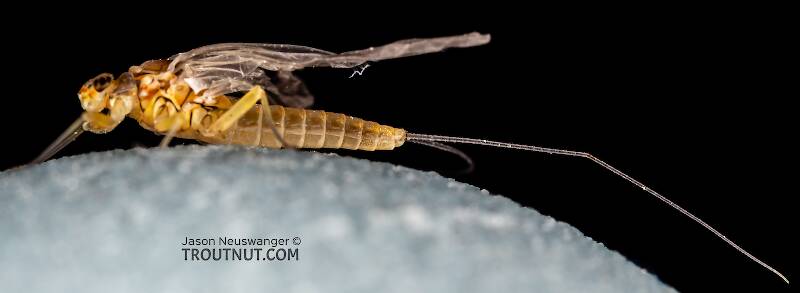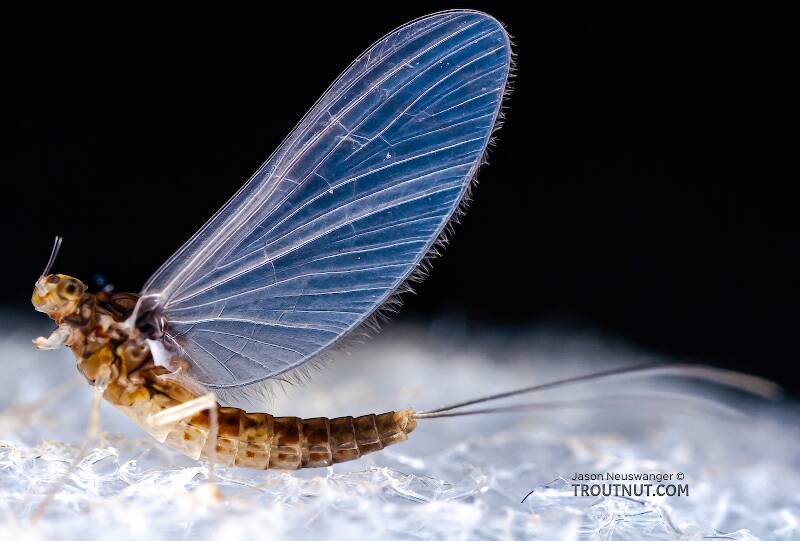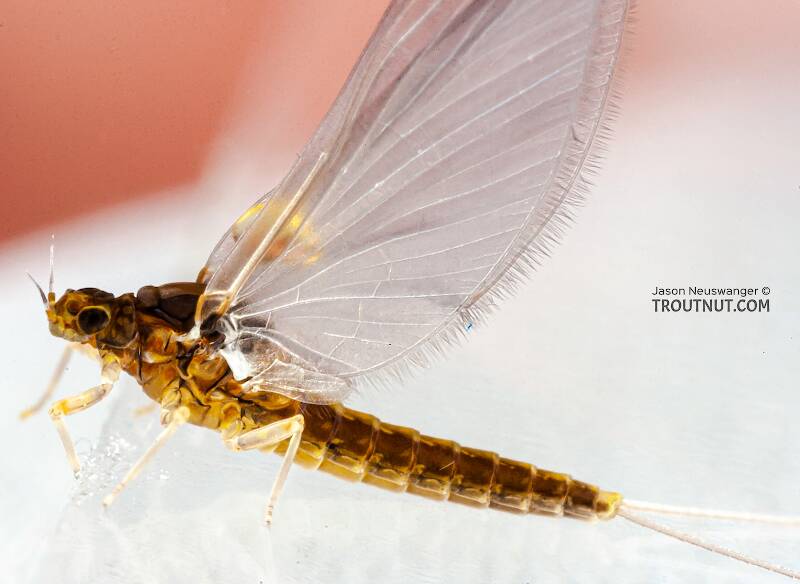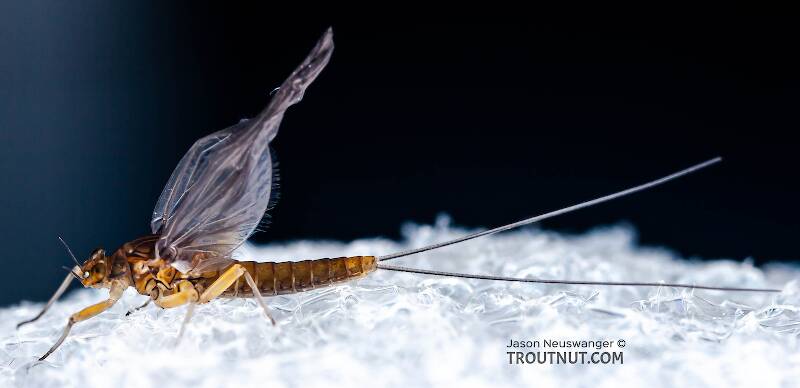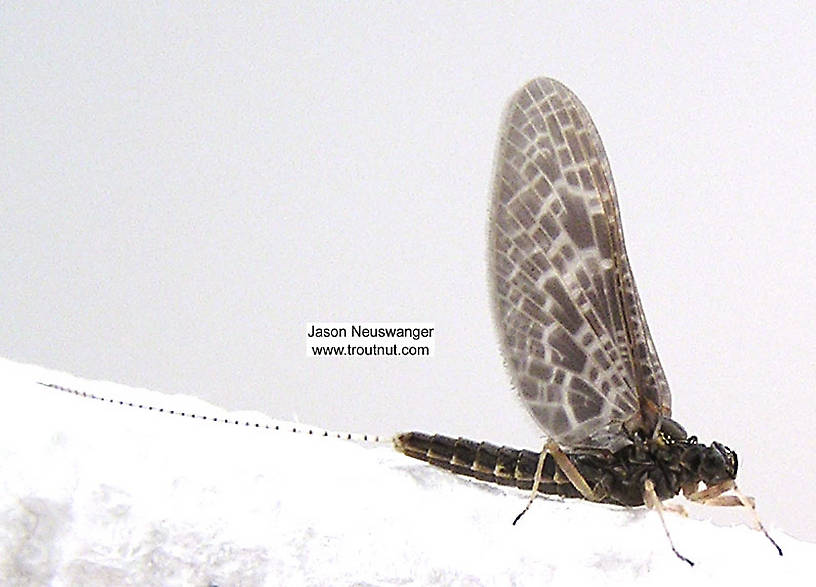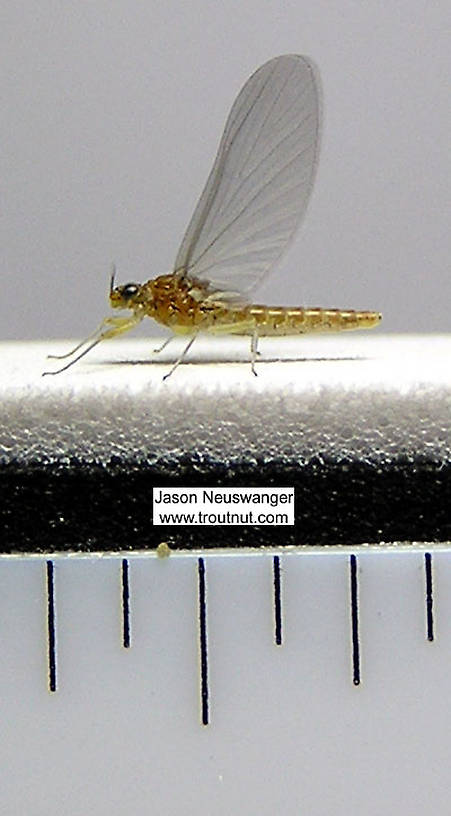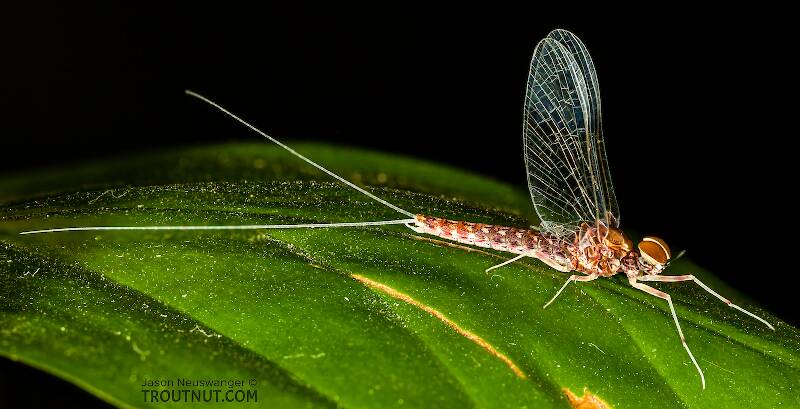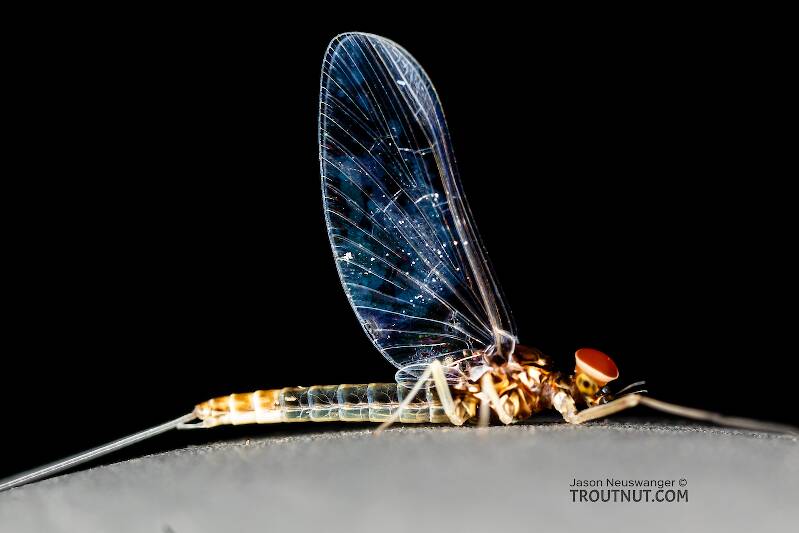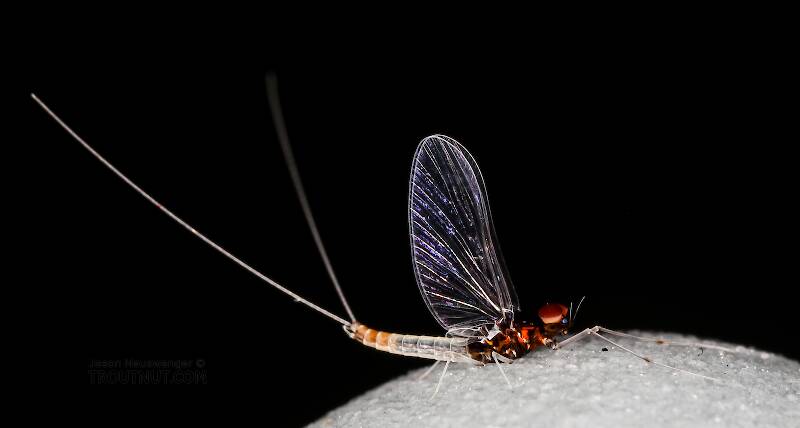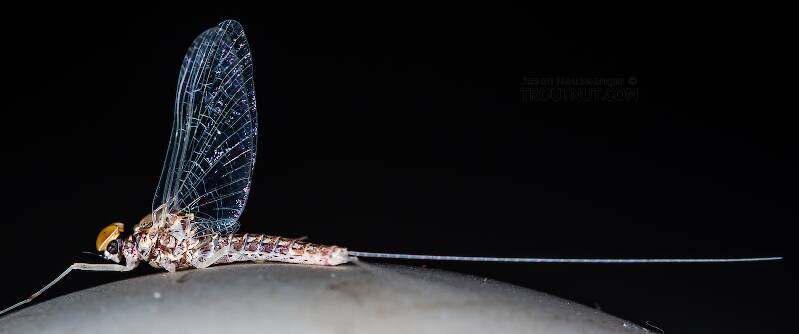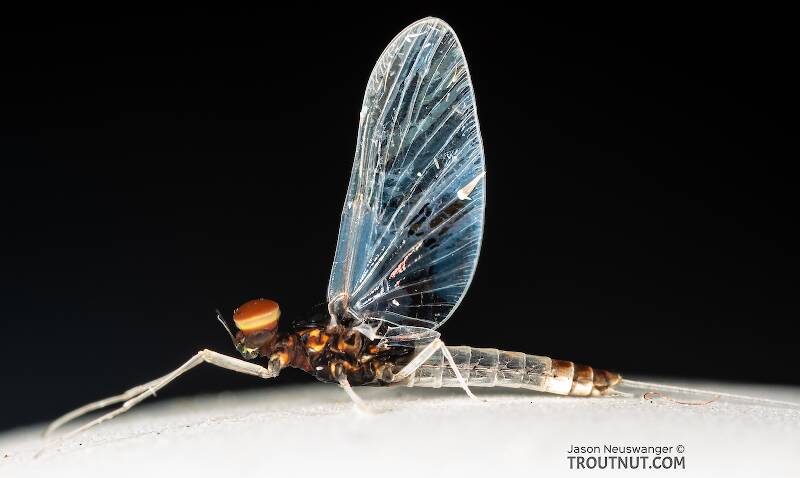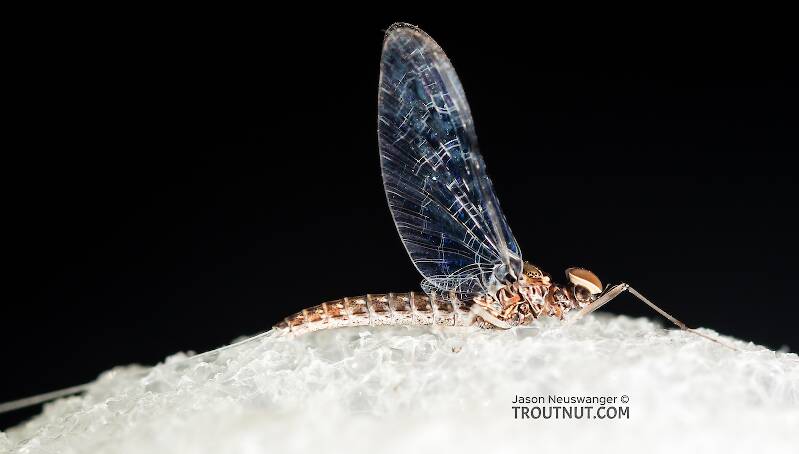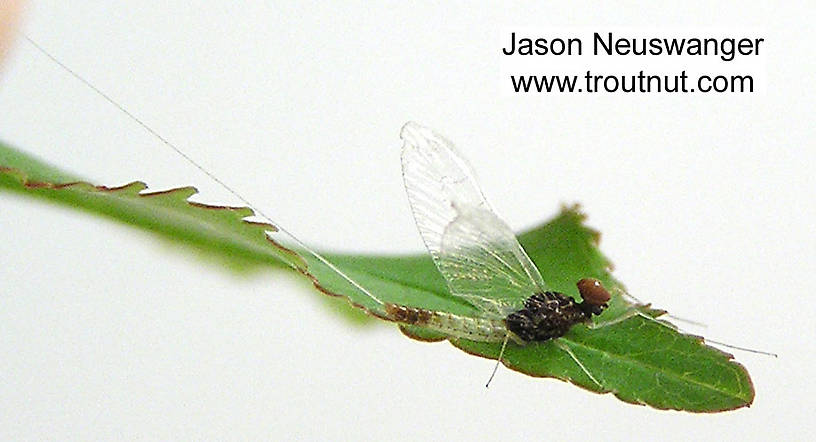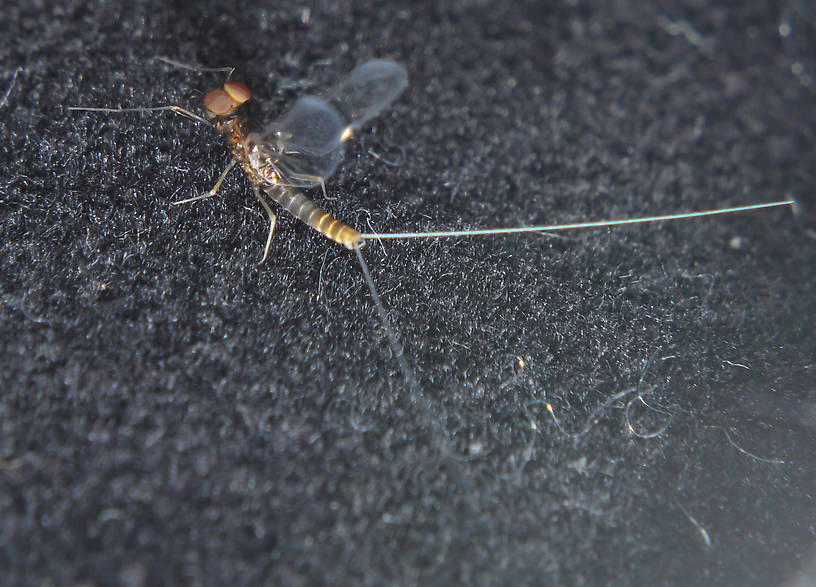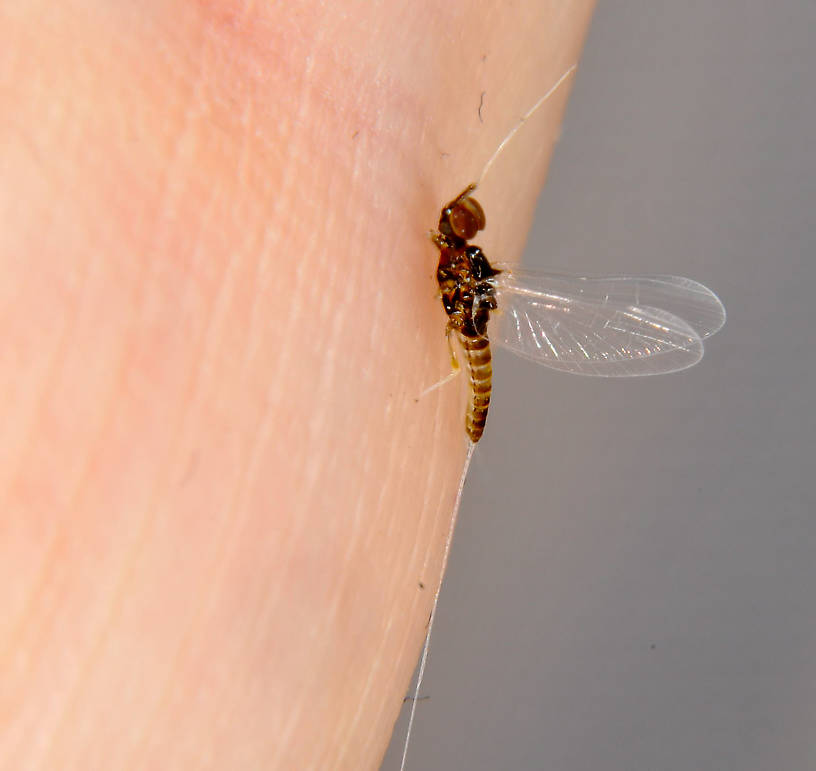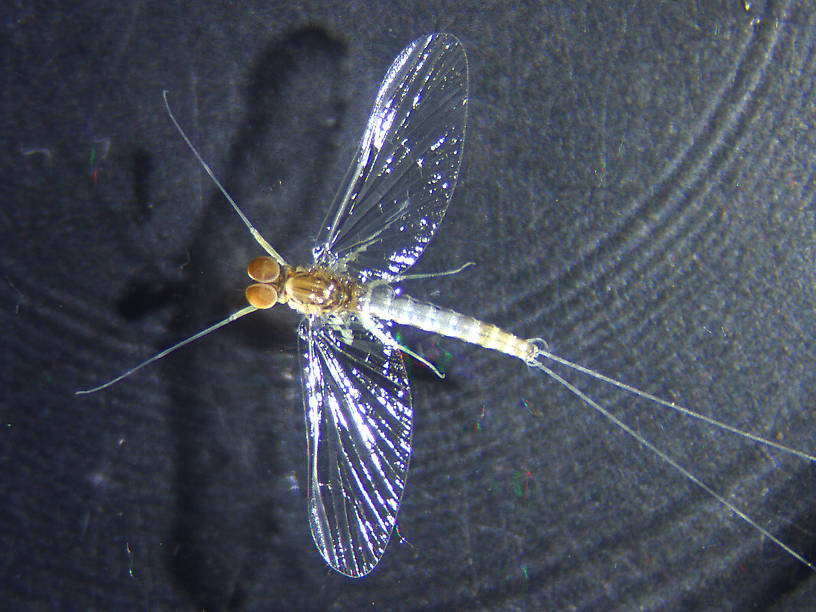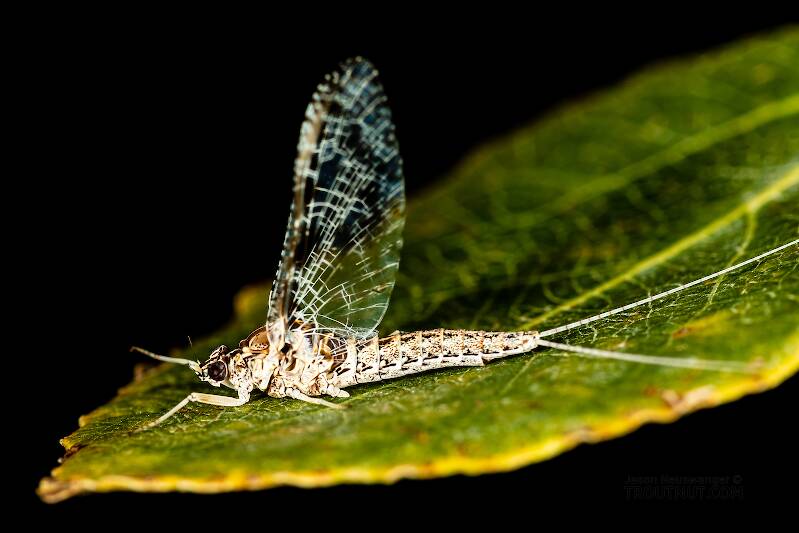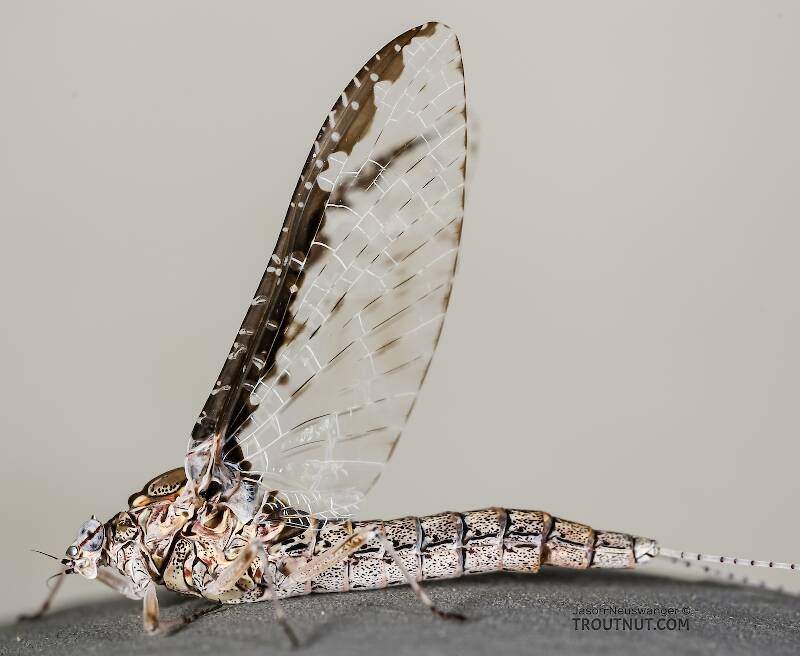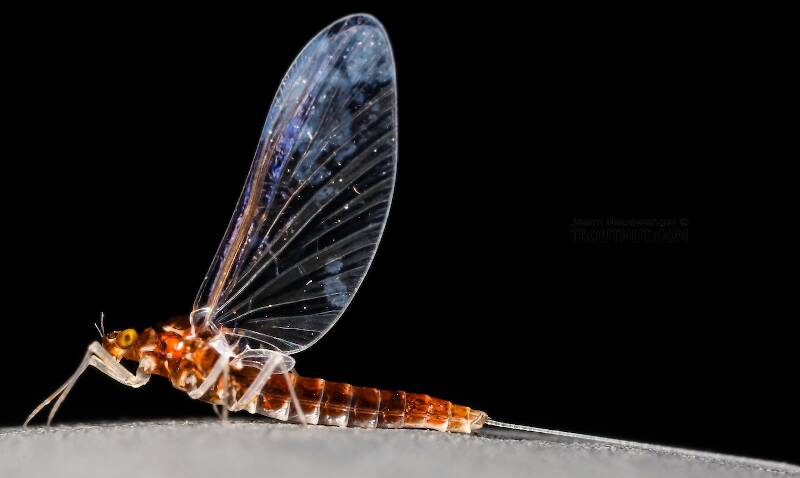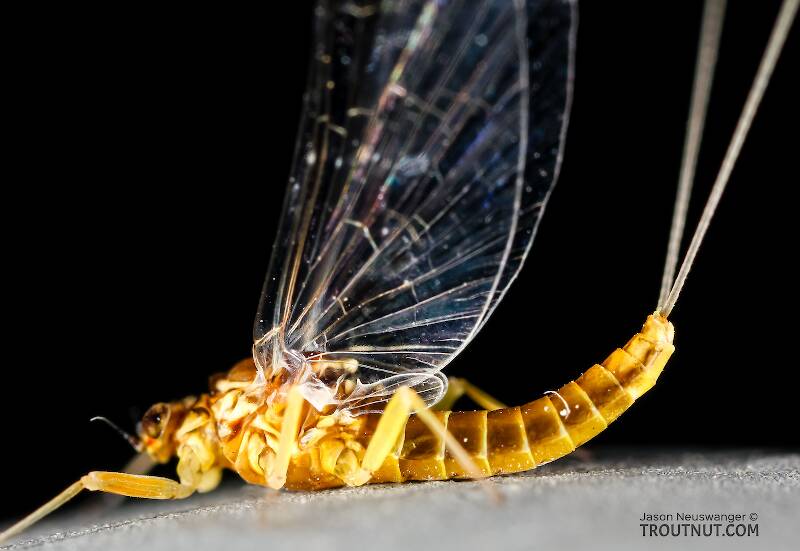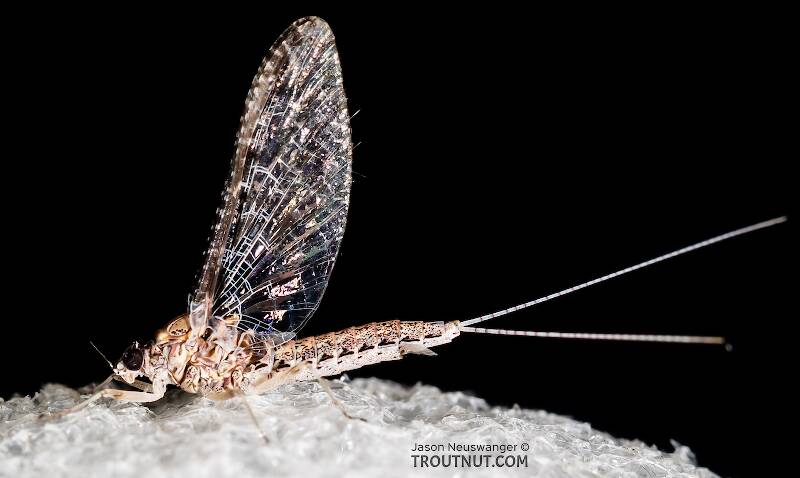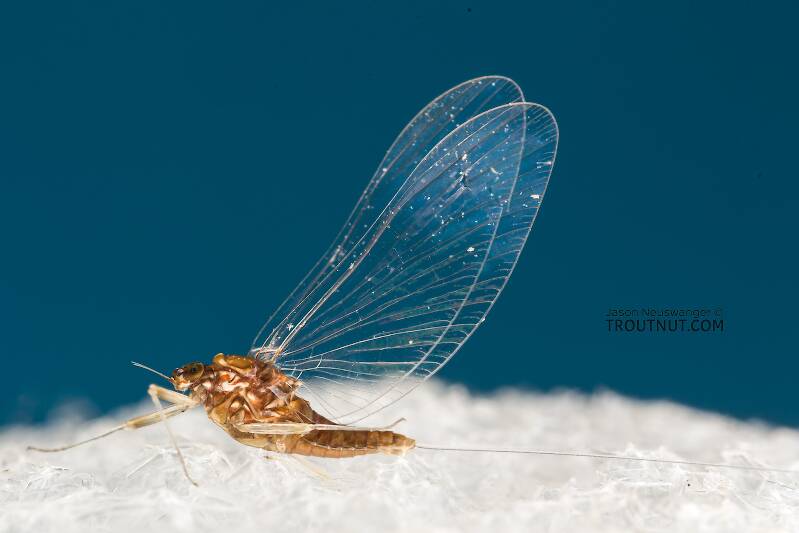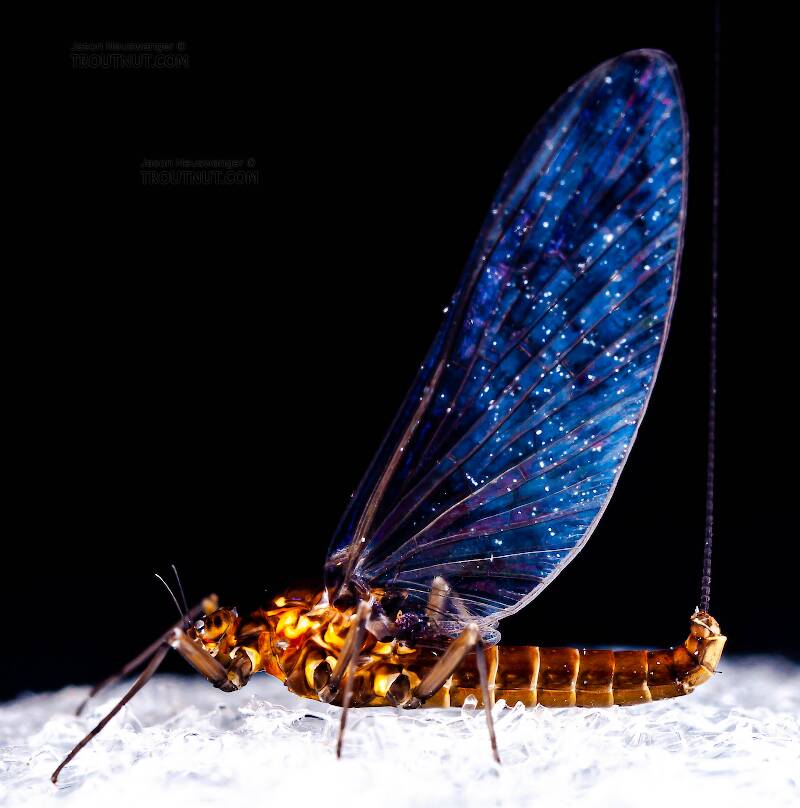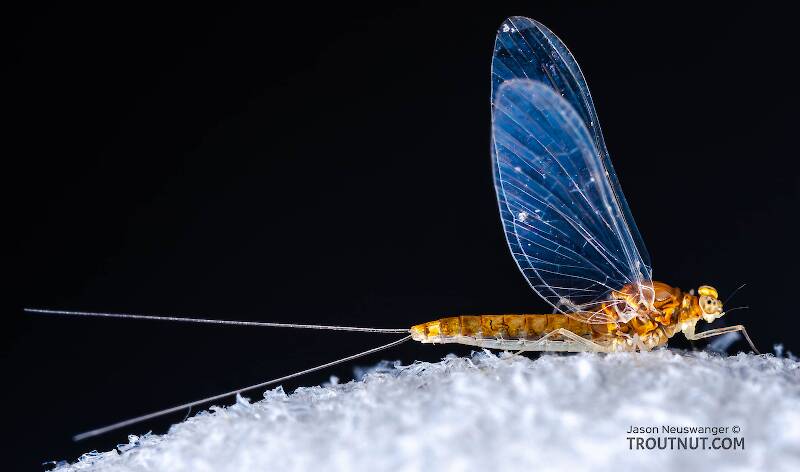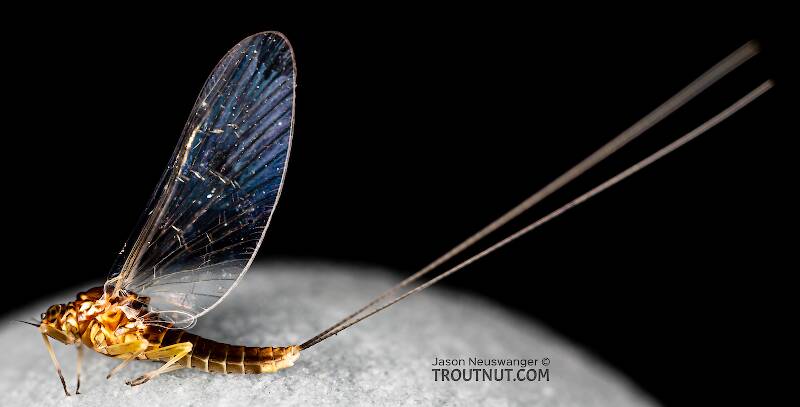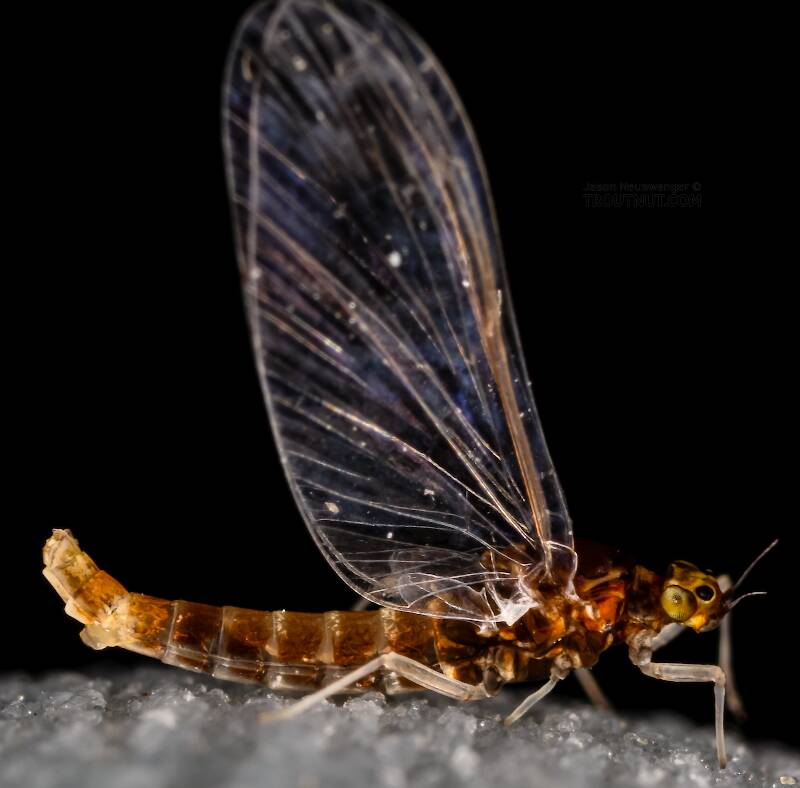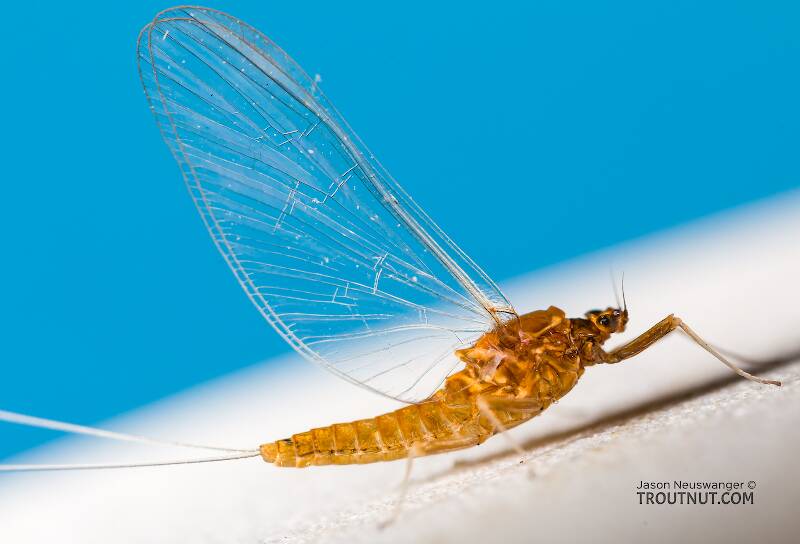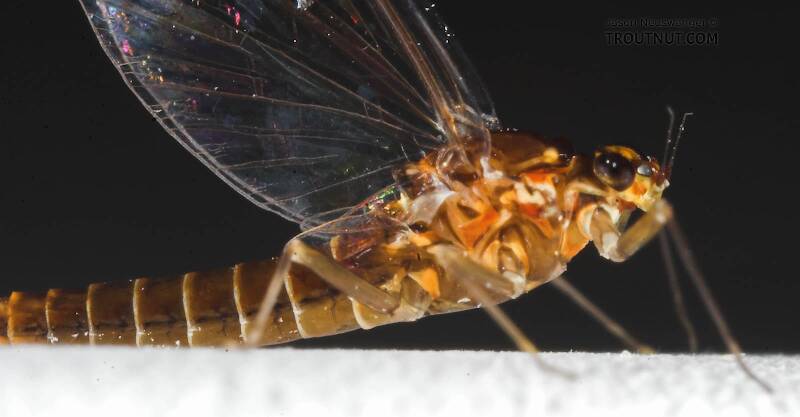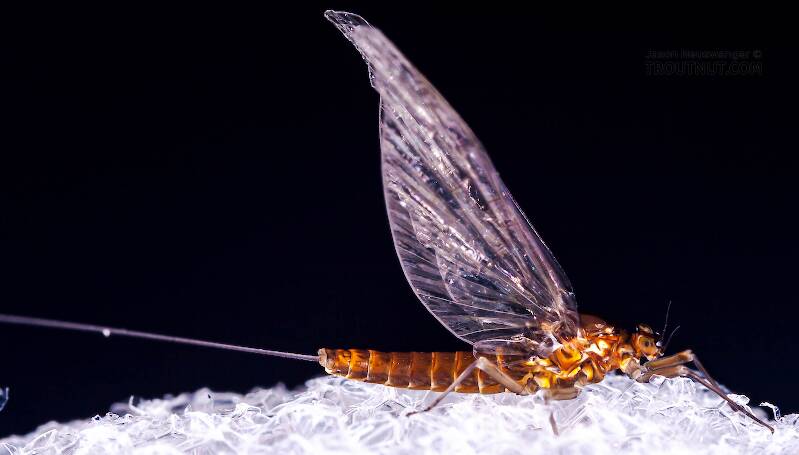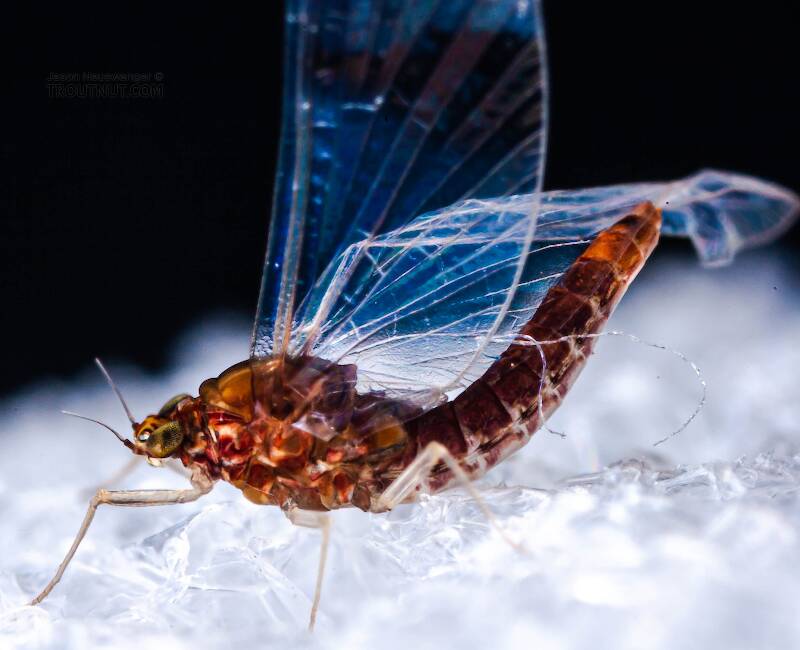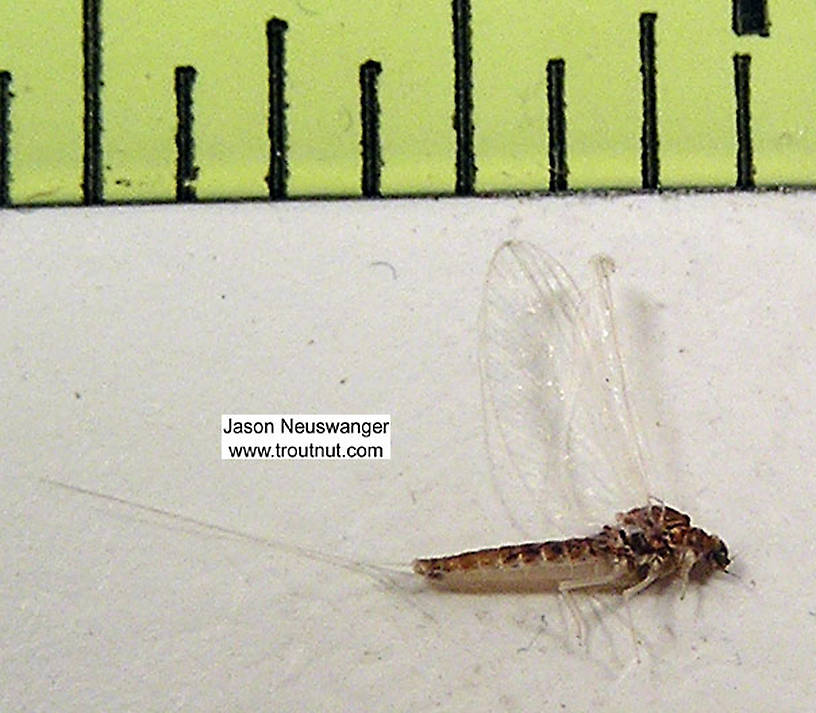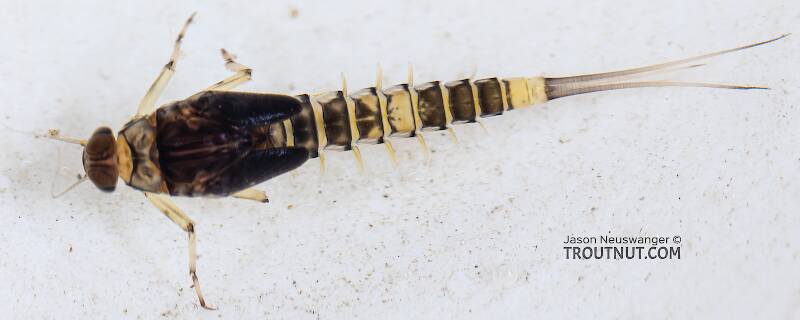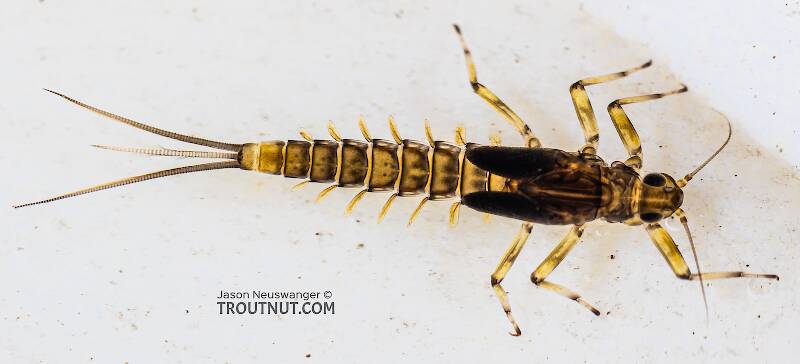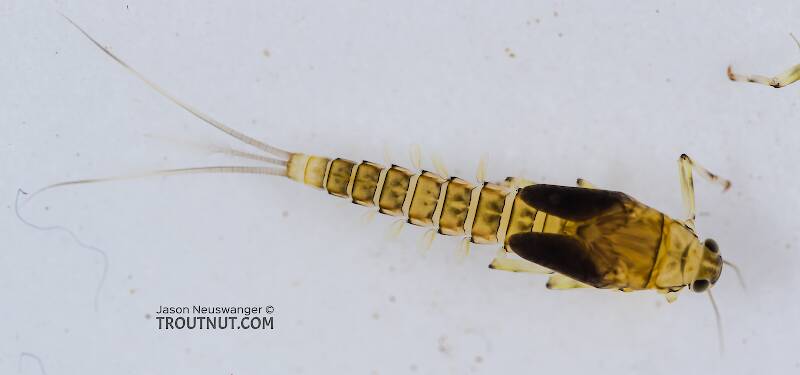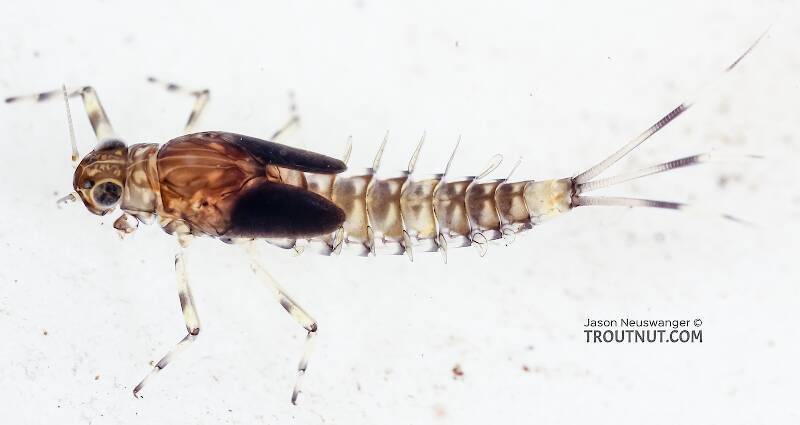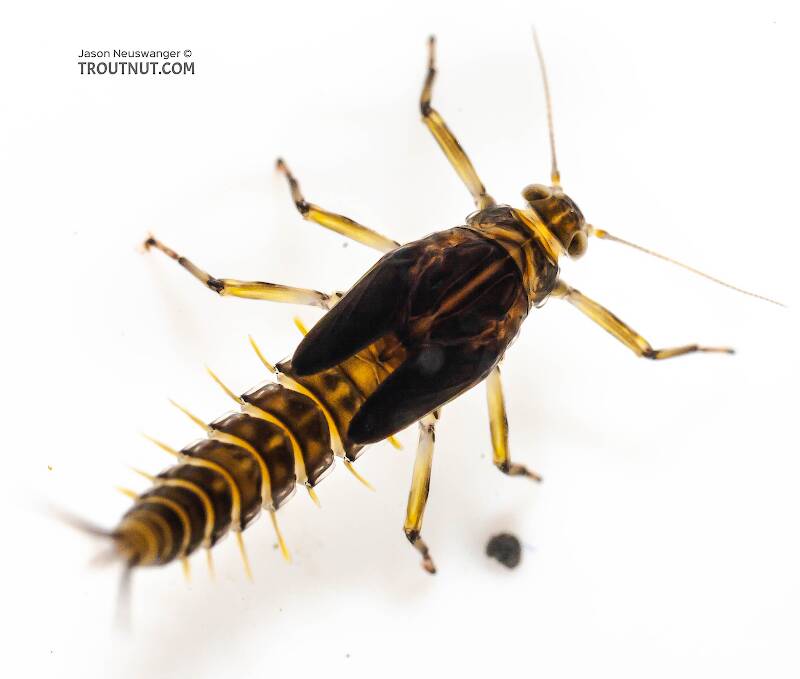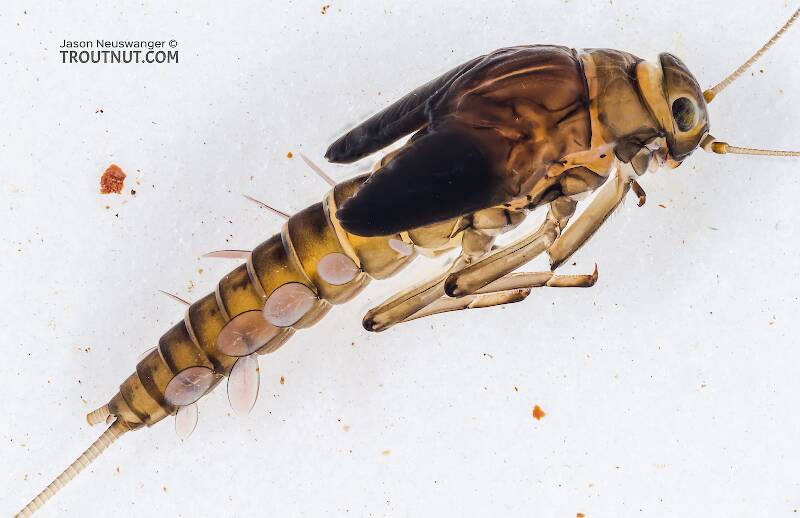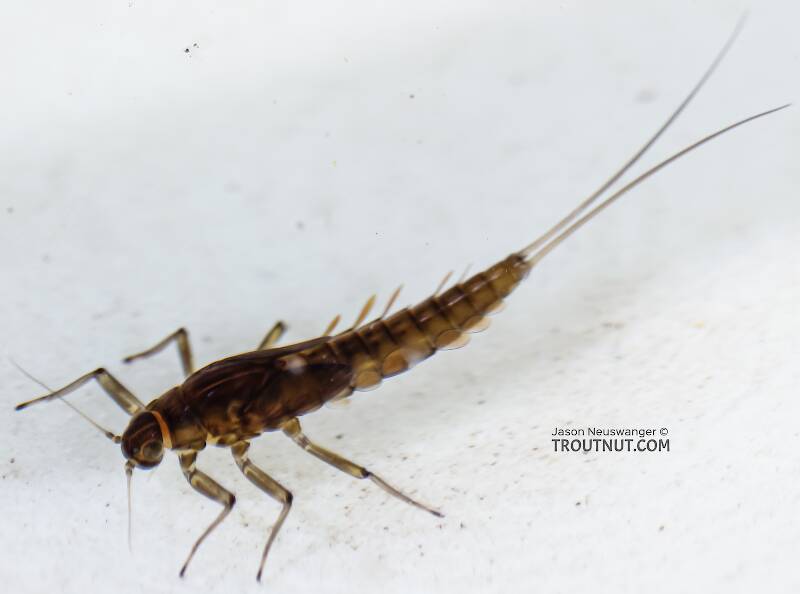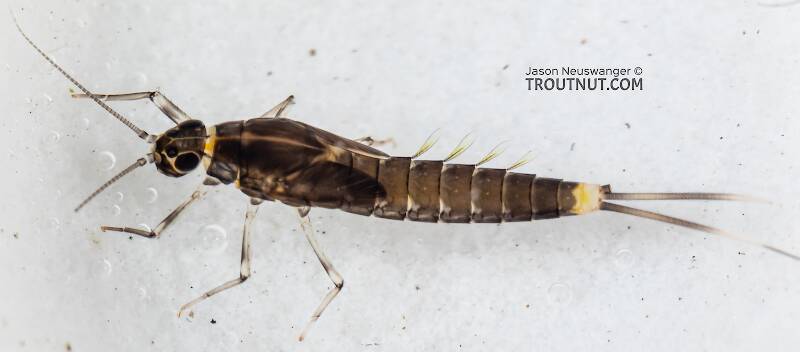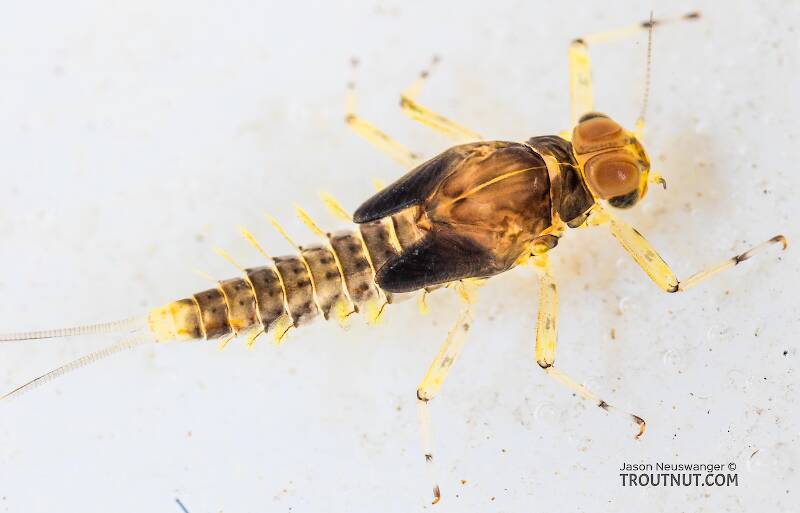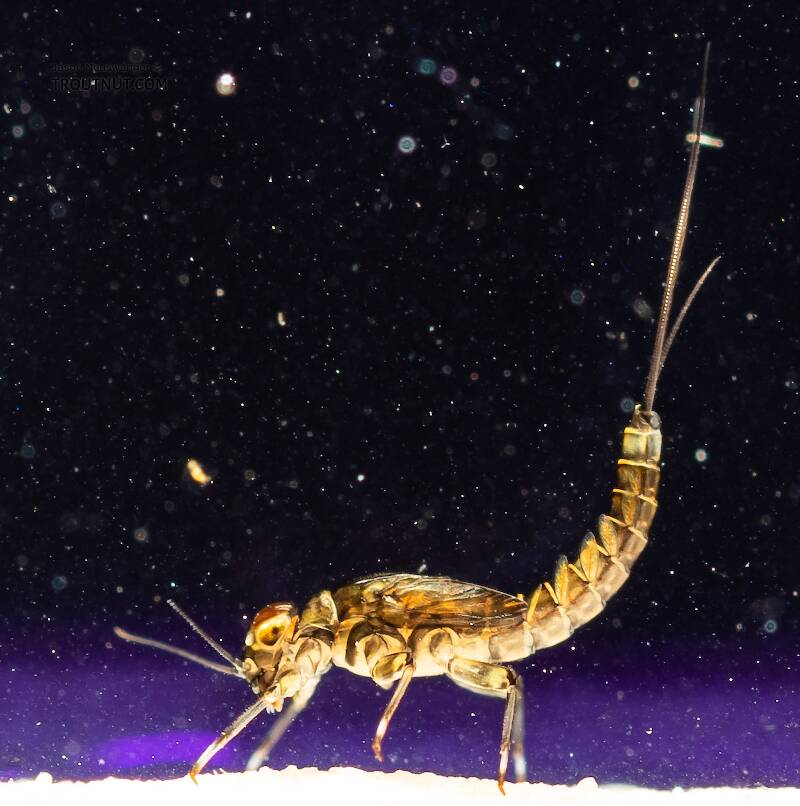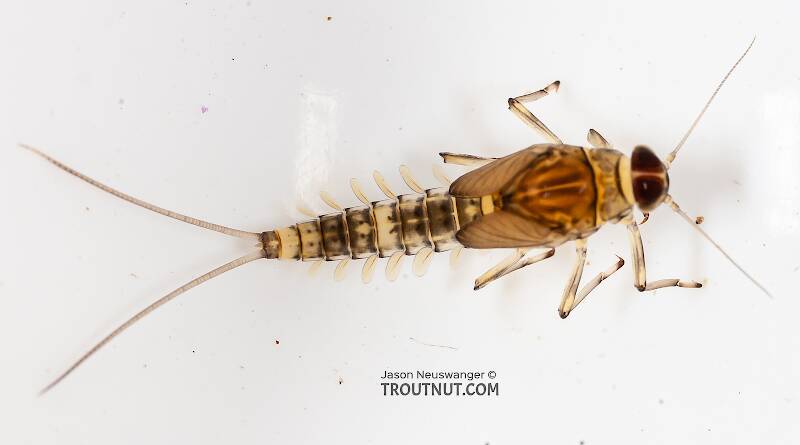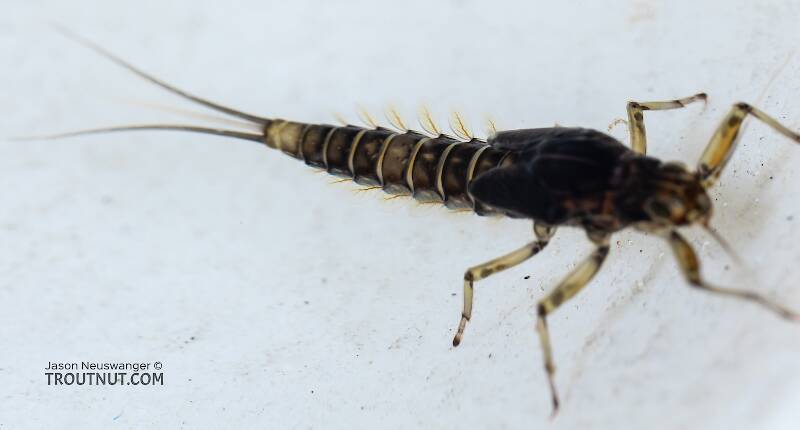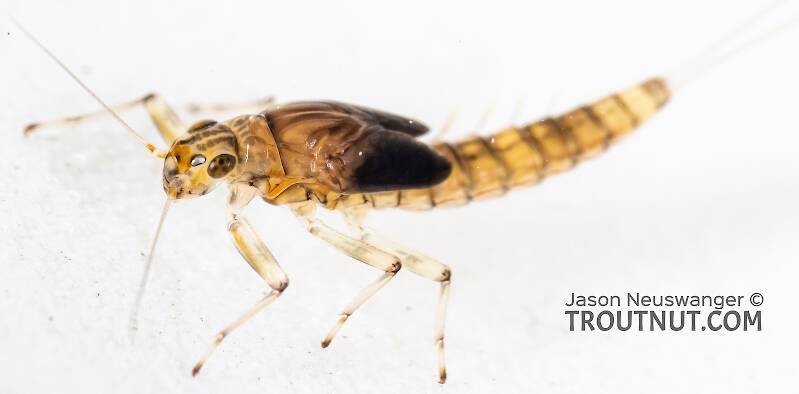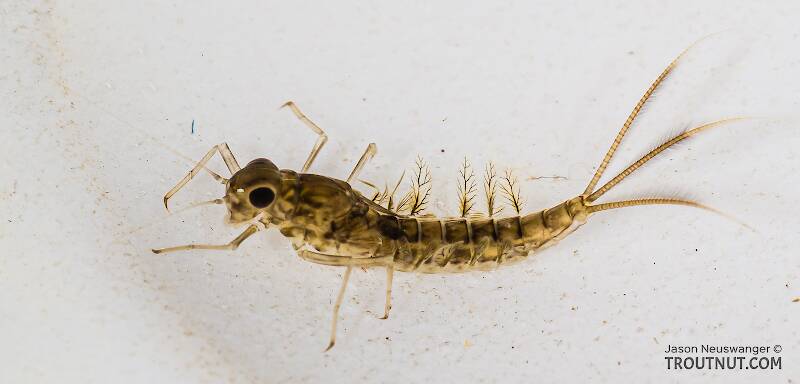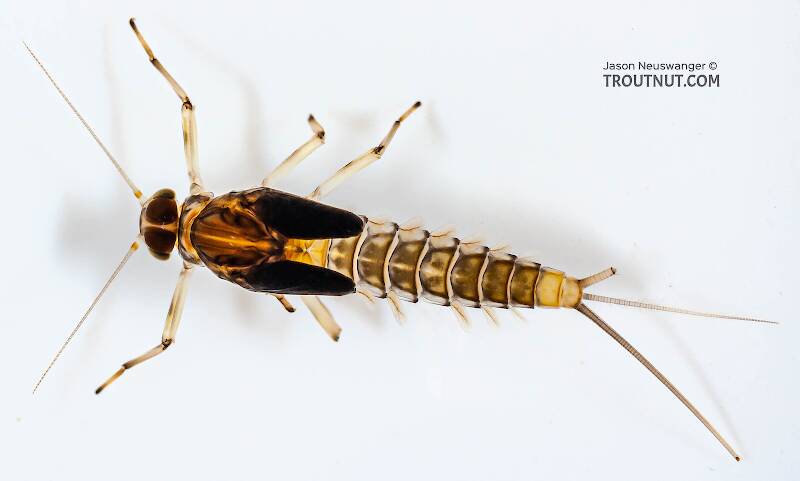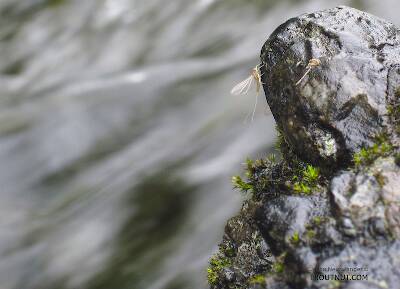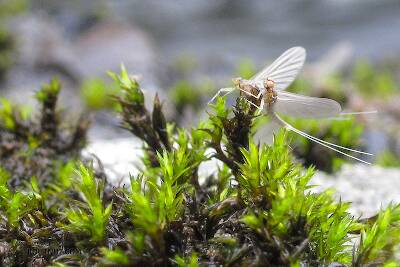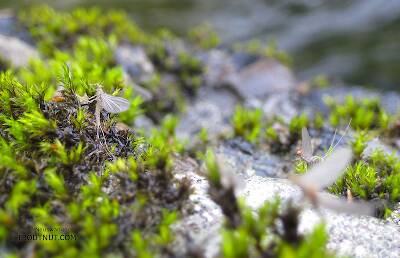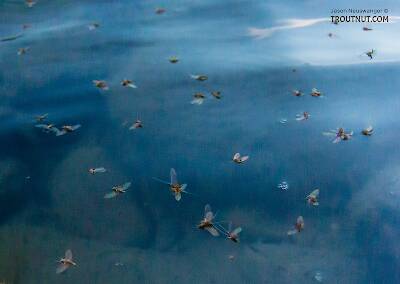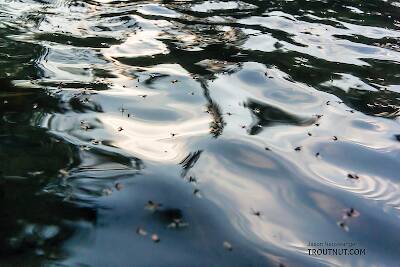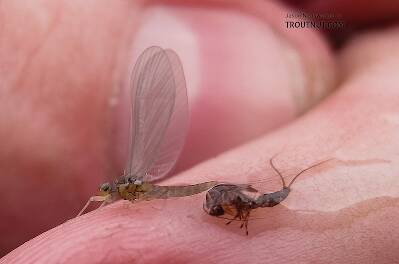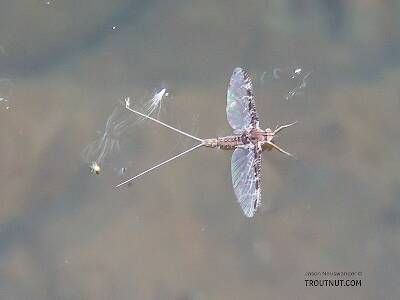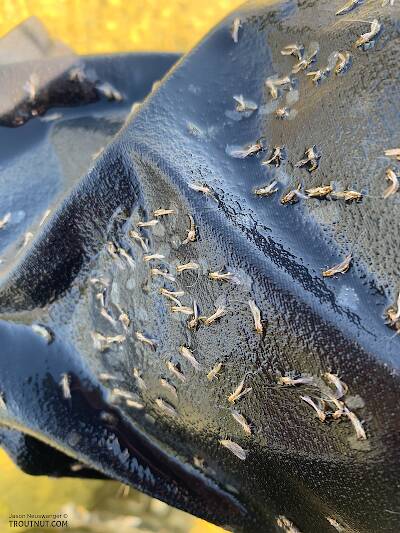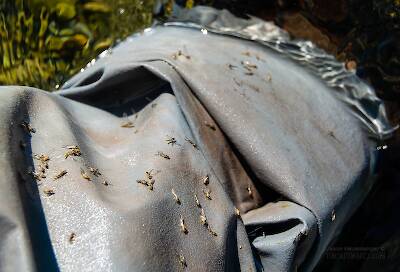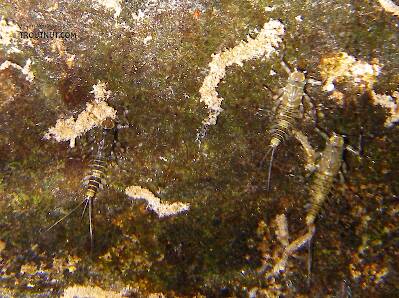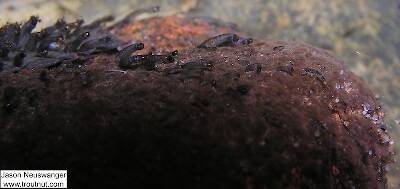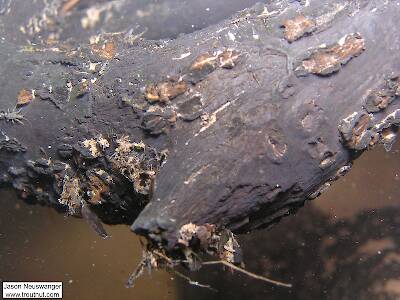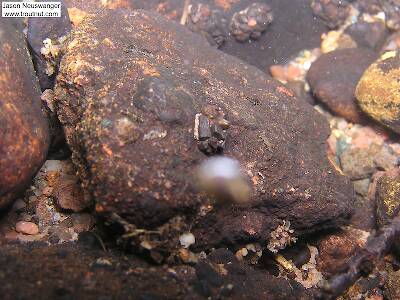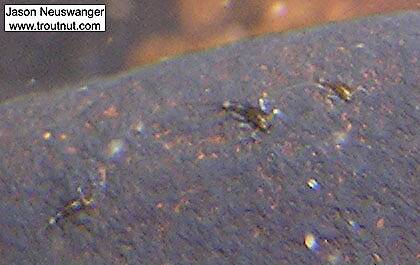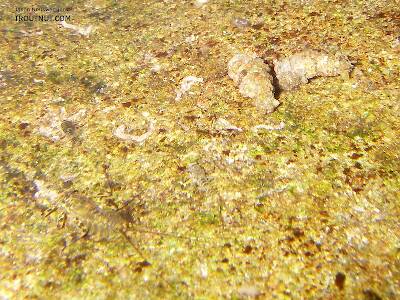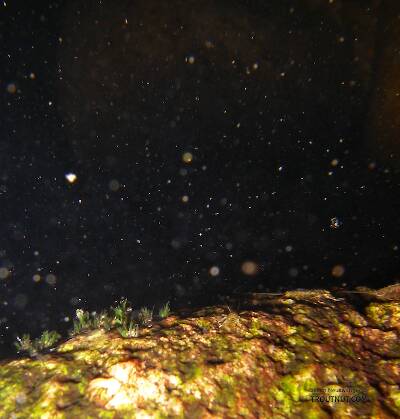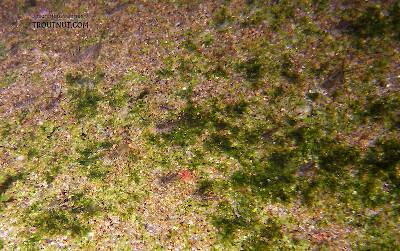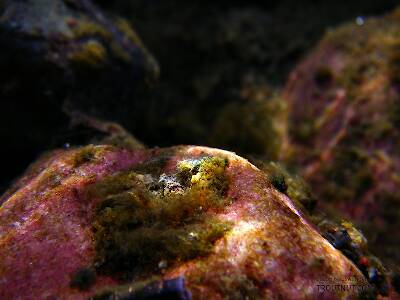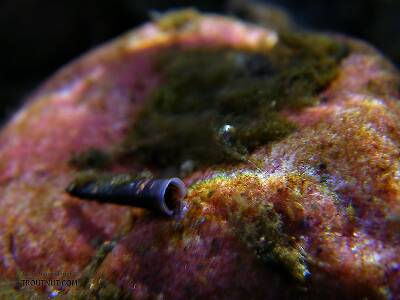
Hex Mayflies
Hexagenia limbata
The famous nocturnal Hex hatch of the Midwest (and a few other lucky locations) stirs to the surface mythically large brown trout that only touch streamers for the rest of the year.
Featured on the forum
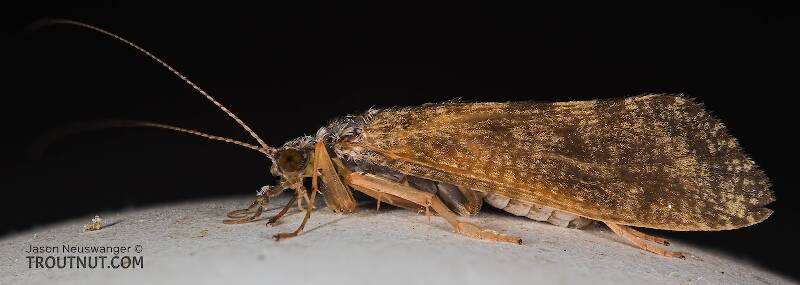

Troutnut is a project started in 2003 by salmonid ecologist Jason "Troutnut" Neuswanger to help anglers and
fly tyers unabashedly embrace the entomological side of the sport. Learn more about Troutnut or
support the project for an enhanced experience here.
Mayfly Family Baetidae (Blue-Winged Olives)
"These little critters supplant the importance of many other well-known mayfly hatches."
-Fred Arbona in Mayflies, the Angler, and the Trout
Arbona did not overestimate these critters. Their great numbers and multiple broods each season make up for their size, which is rarely larger than size 16 and often smaller than size 20.
Hardly mentioned in angling literature prior to the middle of the last century, baetids have become increasingly important to anglers, rivaling any other family of mayflies in this regard. This is largely due to the extension of fishing seasons that now include the early and late periods when this family’s species usually dominate hatching activity. Another important reason is the tremendous improvement in tackle allowing more practical imitation of these little mayflies. The dramatic ecological changes in many of our watersheds and the subsequent impact this has had on the makeup of taxa populations is also a factor.
Common baetid hatches with a national distribution are the species Acentrella turbida, Baetis brunneicolor, and Baetis tricaudatus. In the West, Baetis bicaudatus, Diphetor hageni and Plauditus punctiventris can also be common. In the East and the Midwest, look for Baetis intercalaris and Plauditus dubius. The species Iswaeon anoka is important in both the West and Midwest. Some of the Procloeon and Anafroptilum (previously Centroptilum) species are coming to the increasing notice of anglers across the country.
Stillwater anglers are likely to run across Callibaetis ferrugineus ferrugineus in the East and Midwest. Western anglers will find Callibaetis californicus and Callibaetis ferrugineus hageni to be very important.
Streamside identification of these mayflies to the level of genus, let alone species, has always been difficult. It's a very rare angler who can correctly proclaim a mayfly to be "Baetis" at a glance and be right on purpose, rather than making a lucky (albeit likely) guess at that genus versus the many others in the family. This is now even more so as new taxonomic evidence has shown hind wing conformation (or lack of hind wings) and other features are less dependable as ways to tell the genera apart. Many of the lesser-known species probably produce excellent local hatches but have not caught enough attention to be properly recognized by anglers. The lesson is that we should not assume anything about the identity of many Baetidae hatches we come across; they may not even be in the Baetis genus, let alone familiar species.
Taxonomic History
Taxonomically speaking, this is an unruly family. The entomological community seems to be perpetually reclassifying its genera and species to the chagrin of many anglers. These changes are not capricious. The reason is older nomenclatures haven't provided the taxonomic flexibility required as more becomes known about the complexities of baetid relationships. Classification of this family’s genera and species is very much a work in progress. The changes have been so extensive that it is beyond the scope of this hatch page to track the taxonomic history effectively without interjecting even more confusion. If you are frustrated by the inability to find some of the old familiar names, you're not alone. Rest assured these popular hatches are listed here, just under the latest classifications. The old famous names are referenced in their hatch pages.
Where & when
In 981 records from GBIF, adults of this family have mostly been collected during June (25%), July (24%), August (15%), May (12%), April (8%), and September (7%).
In 1450 records from GBIF, this family has been collected at elevations ranging from -66 to 29016 ft, with an average (median) of 2854 ft.
Family Range
Hatching behavior
The Baetidae mayflies are so important, in part, because their life cycles include several points of unusually high vulnerability to trout. They emerge on the surface, and the nymphs may drift just under it for a while before breaking through. They have trouble escaping their shucks in the film, taking a long time and often becoming stuck in the process. Those which do escape may ride the water for quite a distance before taking flight.Nymph biology
The fast-swimming Baetidae nymphs are an important trout food even during non-hatch periods. The popular Pheasant Tail Nymph pattern, in small sizes, imitates them fairly well.Identification
To determine whether a specimen of Ephemeroptera belongs to Baetidae, use the Key to Families of Mayfly Nymphs or Key to Families of Mayfly Duns and Spinners.
Specimens of the Mayfly Family Baetidae
10 Male Duns
15 Female Duns
10 Male Spinners
15 Female Spinners
15 Nymphs
10 Streamside Pictures of Baetidae Mayflies:
10 Underwater Pictures of Baetidae Mayflies:
Discussions of Baetidae
Possible ID
1 replies
Posted by Sreyadig on Apr 11, 2021 in the species Apobaetis futilis
Last reply on Apr 11, 2021 by Taxon
In searching for nymphs in my small stream in northern Maryland, 500 yards from the PA line, I came across a 2 tailed mayfly that was not a of the Epeorus genus.
It was in a fast riffle section along with Epeorus nymphs. This was about 3/8” in overall length including tails. Darker straw coloration with dark brownish black wing cases that were pronounced in color and shape. Biggest factor was the tails. Median caudal filament was truncated, very small compared to the outer pair. Not even sure if tail/ caudal filament should be used to describe. In my books the closest thing is the Pseudocloeon futile. Which is an old taxonomic name I’m finding out.
This find seems rare in my area and experience. Hopefully I can get a photo...
It was in a fast riffle section along with Epeorus nymphs. This was about 3/8” in overall length including tails. Darker straw coloration with dark brownish black wing cases that were pronounced in color and shape. Biggest factor was the tails. Median caudal filament was truncated, very small compared to the outer pair. Not even sure if tail/ caudal filament should be used to describe. In my books the closest thing is the Pseudocloeon futile. Which is an old taxonomic name I’m finding out.
This find seems rare in my area and experience. Hopefully I can get a photo...
Mayfiles other than Callibaetis
1 replies
Posted by Royal_Coach on Jan 15, 2018 in the genus Callibaetis
Last reply on Jan 15, 2018 by Millcreek
every book/article I read says Baetidae is the most imporant family and Callibaetis the most important genus of mayfly. Why? Does this just mean they are the most prolific? Am I not likely to encounter any other family/genus on a western river?
Big Green River, Wisconsin, late September
1 replies
Posted by Admiralb on Sep 28, 2013 in the species Baetis brunneicolor
Last reply on Sep 30, 2013 by Entoman
I hosted two visiting delegates to the T.U. National Convention in Madison, WI. on September 25, 2013, taking them to the Big Green River in Grant County near Fennimore. There was a high overcast in the morning, and these mayflies [which I merely called "BWO's" and imitated with #16 parachute dries - thin olive bodies, gray wing posts and dun parachute hackle] - were active. Both of my guests raised browns fishing a gray nymph behind a #16 parachute dry BWO. As long as my flies catch fish, I don't need to be a detailed entomologist. Nevertheless, I do sincerely appreciate the detailed scientific info, because it helps me focus my flytying and fly selection. Thank you.
Instant Baetid Nymph Patterns
36 replies
Posted by PaulRoberts on Feb 1, 2012
Last reply on Mar 7, 2013 by PaulRoberts
Often the first fishing for bug-eaters I do every year is the early Baetis activity. Then…the Baetid activity just continues through the year on virtually all the waters I fish. This is probably so for you all too.
I often fish a Baetid dry ahead of a Baetid nymph, since individual fish could be targeting either. I fish the #18 or #20 nymph on a short (~18-24”) length of 7x to the bend of the hook of a #16 Parachute dry. A tiny daub of tungsten putty helps the short fine dropper break the surface film, as it’s critical to have the dropper line as straight as possible as soon as possible so I can detect every take. I use this combination all year and it's even a smart prospecting rig on waters calm enough to see the small dry.
For my bread-n-butter recipes I can be a pretty lazy tier, so I want as close to an instant tie as I can get. The following are two ~4 minute recipes:
Parafilm Baetid:
This pattern uses a single section of mallard flank barbs (tinted ahead of time with a swipe of a permanent marker) for both the tail and the legs, using the tips for the tail and the butts for the legs. Parafilm (laboratory thermo-plastic film) is used for the body, and tinted with permanent markers. The Parafilm body makes the fly sink a little quicker than dubbed ones, esp with a heavy iron (like the 3906 in this pic).
It’s important to me to have the fly drift correctly in the water, not flip upside down. So it needs an ample tail to right the hook when it’s tethered. Also, with the Parafilm body it helps to adjust the legs with thread so they angle upwards, so they are above the central plane of the fly. I take the most time on this fly with the legs so they are equal on each side in number, length, thickness, and orientation. No need to be anatomically correct so two legs to a side is enough to suggest legs. I suspect the upside down or rolling flies affect my catch rate, as I’ve had repeated refusals to such flies and then made good by tying on a fresh one.

(Yeah, I know there are 4 legs on the left side -I snipped off #3 after I noticed.)

Baetid #2:
The second pattern is similar to a combination of the “WD40” and "Kimball's Emerger", except that it doesn’t bother with the wingcase. The wingcase is suggested with permanent markers: a spot of dark brown behind the head, and two black wing-buds. Again the tinted duck flank for tail and legs, then olive thread for the abdomen, a pale pinkish-golden dubbing for the thorax. Legs equal again, but not so critical that they ride well above the central (dorsal/ventral) plane, as the dubbing adds some buoyancy. The legs should not hang below the plane or the fly will likely ride upside down.



{EDIT}: Just noticed this fly has the wingcase, but I usually just omit it.
I tie a few others too, but these cover the dropper nymph deal pretty well for me.
What Baetid nymph patterns do you rely on?
I often fish a Baetid dry ahead of a Baetid nymph, since individual fish could be targeting either. I fish the #18 or #20 nymph on a short (~18-24”) length of 7x to the bend of the hook of a #16 Parachute dry. A tiny daub of tungsten putty helps the short fine dropper break the surface film, as it’s critical to have the dropper line as straight as possible as soon as possible so I can detect every take. I use this combination all year and it's even a smart prospecting rig on waters calm enough to see the small dry.
For my bread-n-butter recipes I can be a pretty lazy tier, so I want as close to an instant tie as I can get. The following are two ~4 minute recipes:
Parafilm Baetid:
This pattern uses a single section of mallard flank barbs (tinted ahead of time with a swipe of a permanent marker) for both the tail and the legs, using the tips for the tail and the butts for the legs. Parafilm (laboratory thermo-plastic film) is used for the body, and tinted with permanent markers. The Parafilm body makes the fly sink a little quicker than dubbed ones, esp with a heavy iron (like the 3906 in this pic).
It’s important to me to have the fly drift correctly in the water, not flip upside down. So it needs an ample tail to right the hook when it’s tethered. Also, with the Parafilm body it helps to adjust the legs with thread so they angle upwards, so they are above the central plane of the fly. I take the most time on this fly with the legs so they are equal on each side in number, length, thickness, and orientation. No need to be anatomically correct so two legs to a side is enough to suggest legs. I suspect the upside down or rolling flies affect my catch rate, as I’ve had repeated refusals to such flies and then made good by tying on a fresh one.

(Yeah, I know there are 4 legs on the left side -I snipped off #3 after I noticed.)

Baetid #2:
The second pattern is similar to a combination of the “WD40” and "Kimball's Emerger", except that it doesn’t bother with the wingcase. The wingcase is suggested with permanent markers: a spot of dark brown behind the head, and two black wing-buds. Again the tinted duck flank for tail and legs, then olive thread for the abdomen, a pale pinkish-golden dubbing for the thorax. Legs equal again, but not so critical that they ride well above the central (dorsal/ventral) plane, as the dubbing adds some buoyancy. The legs should not hang below the plane or the fly will likely ride upside down.



{EDIT}: Just noticed this fly has the wingcase, but I usually just omit it.
I tie a few others too, but these cover the dropper nymph deal pretty well for me.
What Baetid nymph patterns do you rely on?
North Country Spiders for Baetids
27 replies
Posted by Entoman on Oct 25, 2011
Last reply on Feb 16, 2012 by Softhackle
I wanted to share a couple of patterns that have proven very successful over the years (and the last several weeks in particular) when baetids are about. They hale from England where they have been popular for a very long time. Their construction is simple - silk thread, a wing covert or shoulder hackle, bee's wax, and maybe the merest smidgen of natural dubbing on a few of them. No plastic flash, no head cement, just natural materials delicately applied. There's something very elegant in their understated appearance, and boy do they work! Their thin bodies and sparseness ape the baetids perfectly and the hook set is enhanced as well.
Fished dead drift or under a controlled swing with the rod elevated, they can be deadly when the small stuff is awash in the drift. The two patterns below are the Waterhen Bloa and the Snipe & Purple both in the class of wet flies called North Country Spiders. I find them especially valuable for fishing during baetid spinner activity on freestone rivers in the moderate to slow current sections. They also work fishing "under" the hatch of duns. I never know which one they will prefer, nor have I found any increase in catch rate by doubling up on the one they do for that day, so I just tie 'em both on and leave it be.
Size 16 Waterhen Bloa

Size 18 Snipe & Purple

Fished dead drift or under a controlled swing with the rod elevated, they can be deadly when the small stuff is awash in the drift. The two patterns below are the Waterhen Bloa and the Snipe & Purple both in the class of wet flies called North Country Spiders. I find them especially valuable for fishing during baetid spinner activity on freestone rivers in the moderate to slow current sections. They also work fishing "under" the hatch of duns. I never know which one they will prefer, nor have I found any increase in catch rate by doubling up on the one they do for that day, so I just tie 'em both on and leave it be.
Size 16 Waterhen Bloa

Size 18 Snipe & Purple

Start a Discussion of Baetidae
References
- Arbona, Fred Jr. 1989. Mayflies, the Angler, and the Trout. Nick Lyons Books.
- Hafele, Rick and Hughes, Dave. 2004. Western Mayfly Hatches. Frank Amato Publications.
- Knopp, Malcolm and Robert Cormier. 1997. Mayflies: An Angler's Study of Trout Water Ephemeroptera . The Lyons Press.
Mayfly Family Baetidae (Blue-Winged Olives)
Taxonomy
Genus in Baetidae
AcentrellaTiny Blue-Winged Olives
7
45
AcerpennaTiny Blue-Winged Olives
5
32
AnafroptilumTiny Sulphur Duns
2
5
ApobaetisTiny Blue-Winged Olives
0
0
BaetisBlue-Winged Olives
36
248
CallibaetisSpeckled Duns
15
76
Camelobaetidius
0
0
CloeonTiny Sulphur Duns
0
0
DiphetorBlue-Winged Olives
1
6
FallceonBlue-Winged Olives
0
0
HeterocloeonTiny Blue-Winged Olives
0
0
IswaeonTiny Blue-Winged Olives
0
0
LabiobaetisTiny Blue-Winged Olives
0
0
Neocloeon
0
0
Paracloeodes
0
0
PlauditusTiny Blue-Winged Olives
0
0
ProcloeonTiny Sulphur Duns
2
9
PseudocloeonTiny Blue-Winged Olives
0
0
Waynokiops
0
0
Genus in Baetidae: Acentrella, Acerpenna, Anafroptilum, Apobaetis, Baetis, Callibaetis, Camelobaetidius, Cloeon, Diphetor, Fallceon, Heterocloeon, Iswaeon, Labiobaetis, Neocloeon, Paracloeodes, Plauditus, Procloeon, Pseudocloeon, Waynokiops
9 genera (Americabaetis, Baetodes, Baetopus, Barbaetis, Cloeodes, Kirmaushenkreena, Moribaetis, Pseudocentroptiloides, and Varipes) aren't included.



